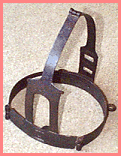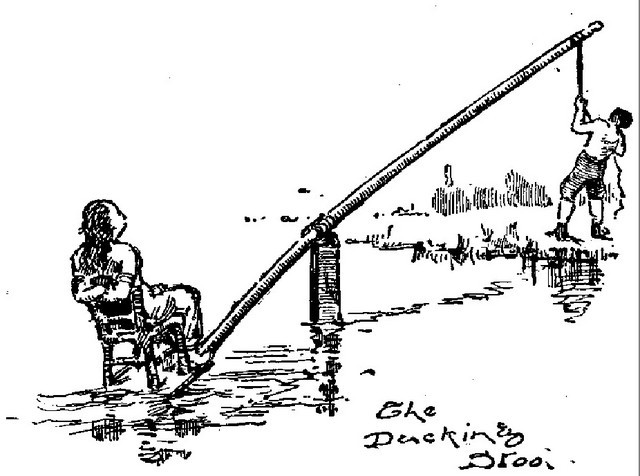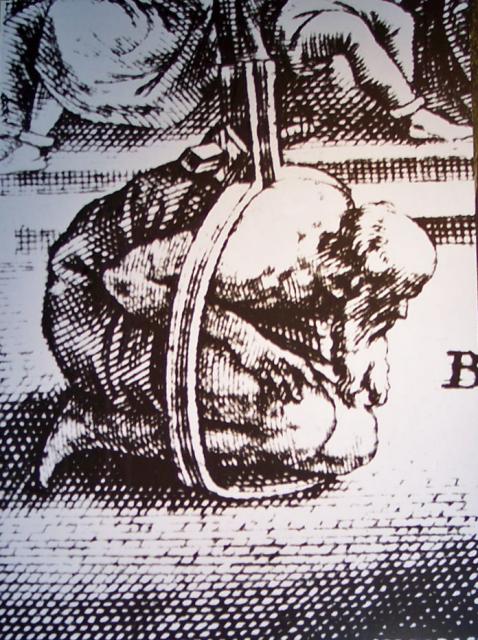Home » Other Stuff »
Punishments in the Olden Days ..... Some Facts
Here are some of the ways of punishments in the olden days
Scold's Bridle
A scold's bridle was a particularly unpleasant form of punishment. A woman would have been forced to sit in full view of the other inmates wearing the bridle which prevented her from speaking.


Whipping
Whipping was a very common form of punishment. It was done publicly as a lesson to other inmates.

Stocks
Rather like the lesser punishment called the stocks, the pillory consisted of hinged wooden boards that formed holes through which the head and/or various limbs were inserted; then the boards were locked together to secure the captive. Pillories were set up in marketplaces and crossroads to hold petty criminals. Often a placard detailing the crime was placed nearby; these punishments generally lasted only a few hours.
Time in the pillory was more dangerous than in the stocks, as the pillory forced the malfeasant to remain standing and exposed.

A criminal in the stocks would expect to be abused, but his life was not targeted. A prisoner in the pillory would be presumed to have committed a more serious crime and accordingly get a more angry crowd reaction. With hands trapped, he could not protect himself from anything thrown at him, either harmless items like rotten food or injurious ones, even heavy stones: blinding, permanent maiming or death could be the consequences. The criminal could also be sentenced to further punishments while in the pillory: humiliation by shaving of some or all of the hair, or regular corporal punishment(s), notably flagellation (the pillory serving as the whipping post), birching, caning or even permanent mutilation such as branding, or having an ear cut off.
Public humiliation was a major part of punishment in stocks and pillories. These would always be sited in the most public place available, for example the market square or village green. In small communities, those being punished would be well known to everyone else, thereby increasing their shame.
Audience participation was a key element. The helpless victim would usually be subjected to a barrage of mockery and abuse, and pelted with any missiles which came to hand. These could range from rotten fruit and vegetables, mud, excrement, dead rats, even stones. This was most effective in the pillory, where the occupant was unable to move his or her head.

The physical discomfort of being confined for long periods in stocks or pillories should not be discounted. People could be left in the stocks for days, even weeks, in all weather. Being stuck in the same position would become very uncomfortable after only a few hours.
The pillory tended to be a shorter term punishment, a few hours, not usually more than a day. But the victim’s position, bent over and unable to move his or her head, was considerably more uncomfortable than the stocks.
As an additional punishment, people in the pillory sometimes had their ears nailed to the boards. Not only was this painful in itself, but the victim’s head was rendered completely immobile. Ears could be torn off by the victim’s futile efforts to dodge missiles hurled by the crowd. If the victim’s ears were still attached to his or her head on completion of the sentence, they would be cut off before the pillory was opened.
The Ducking Stool
The Ducking stool was a punishment strictly designed for women. The crimes which deemed such a punishment were prostitution and witchcraft. Scolds were also punished by this method. A scold was a term given to a gossip, shrew or bad tempered woman during the Middle Ages. A scold was defined as: "A troublesome and angry woman who by brawling and wrangling amongst her neighbours breaks the public peace, increases discord and becomes a public nuisance to the neighbourhood".

The device was used in cases of witchcraft. Ducking was seen as a foolproof way to establish whether a suspect was a witch. The ducking stools were first used for this purpose but ducking was later inflicted without the chair. In this instance the victim's right thumb was bound to left toe. A rope was attached to her waist and the 'witch' was thrown into a river or deep pond. If the 'witch' floated it was deemed that she was in league with the devil, rejecting the 'baptismal water'. If the 'witch' drowned she was deemed innocent. This particular method of ducking was also inflicted on men accused of witchcraft.
The Rack
The Rack by Stretching and Dislocation. Torture was seen as a totally legitimate means for justice to extract confessions, obtain the names of accomplices, obtain testimonies or confessions.

The rack was a machine consisting of a rectangular wooden frame. The wooden frame had a roller at each end. The victim's feet were manacled to one roller, and the wrists were manacled to the other. A handle and ratchet were attached to the top roller and were turned very gradually stepwise to increase the tension on the chains. The victim was tied across a board by his ankles and wrists. The rollers at either end of the board were turned, pulling the body in opposite directions. The victims body was initially stretched. Limbs would be dislocated and prolonged use would end with limbs being torn from their sockets inducing excruciating pain.
Scavenger's Daughter
The Scavenger's Daughter by compressing. Torture was seen as a totally legitimate means for justice to extract confessions, obtain the names of accomplices, obtain testimonies or confessions.

The Scavengers Daughter was a device which was invented in England. This device was designed to have the opposite effect to that of the rack. The body was compressed as opposed to being stretched. This rack was invented by the Lieutenant of the Tower of London during the reign of King Henry VIII of England (1509-1547). The name of the Lieutenant of the Tower of London during this period was Leonard Skevington (aka Leonard Skeffington). A derivation of his name led to the device he initiated, or was the father of - the Scavengers Daughter although it was first referred to as Skeffington's Irons. The device consisted of one single iron bar that connected iron shackles closing round the victim's hands, feet and neck. This rack positioned the head to the knees of the victim in a sitting position. It compressed the body as to force the blood from the nose and ears.
Scold's Bridle
A scold's bridle was a particularly unpleasant form of punishment. A woman would have been forced to sit in full view of the other inmates wearing the bridle which prevented her from speaking.


Whipping
Whipping was a very common form of punishment. It was done publicly as a lesson to other inmates.

Stocks
Rather like the lesser punishment called the stocks, the pillory consisted of hinged wooden boards that formed holes through which the head and/or various limbs were inserted; then the boards were locked together to secure the captive. Pillories were set up in marketplaces and crossroads to hold petty criminals. Often a placard detailing the crime was placed nearby; these punishments generally lasted only a few hours.
Time in the pillory was more dangerous than in the stocks, as the pillory forced the malfeasant to remain standing and exposed.

A criminal in the stocks would expect to be abused, but his life was not targeted. A prisoner in the pillory would be presumed to have committed a more serious crime and accordingly get a more angry crowd reaction. With hands trapped, he could not protect himself from anything thrown at him, either harmless items like rotten food or injurious ones, even heavy stones: blinding, permanent maiming or death could be the consequences. The criminal could also be sentenced to further punishments while in the pillory: humiliation by shaving of some or all of the hair, or regular corporal punishment(s), notably flagellation (the pillory serving as the whipping post), birching, caning or even permanent mutilation such as branding, or having an ear cut off.
Public humiliation was a major part of punishment in stocks and pillories. These would always be sited in the most public place available, for example the market square or village green. In small communities, those being punished would be well known to everyone else, thereby increasing their shame.
Audience participation was a key element. The helpless victim would usually be subjected to a barrage of mockery and abuse, and pelted with any missiles which came to hand. These could range from rotten fruit and vegetables, mud, excrement, dead rats, even stones. This was most effective in the pillory, where the occupant was unable to move his or her head.

The physical discomfort of being confined for long periods in stocks or pillories should not be discounted. People could be left in the stocks for days, even weeks, in all weather. Being stuck in the same position would become very uncomfortable after only a few hours.
The pillory tended to be a shorter term punishment, a few hours, not usually more than a day. But the victim’s position, bent over and unable to move his or her head, was considerably more uncomfortable than the stocks.
As an additional punishment, people in the pillory sometimes had their ears nailed to the boards. Not only was this painful in itself, but the victim’s head was rendered completely immobile. Ears could be torn off by the victim’s futile efforts to dodge missiles hurled by the crowd. If the victim’s ears were still attached to his or her head on completion of the sentence, they would be cut off before the pillory was opened.
The Ducking Stool
The Ducking stool was a punishment strictly designed for women. The crimes which deemed such a punishment were prostitution and witchcraft. Scolds were also punished by this method. A scold was a term given to a gossip, shrew or bad tempered woman during the Middle Ages. A scold was defined as: "A troublesome and angry woman who by brawling and wrangling amongst her neighbours breaks the public peace, increases discord and becomes a public nuisance to the neighbourhood".

The device was used in cases of witchcraft. Ducking was seen as a foolproof way to establish whether a suspect was a witch. The ducking stools were first used for this purpose but ducking was later inflicted without the chair. In this instance the victim's right thumb was bound to left toe. A rope was attached to her waist and the 'witch' was thrown into a river or deep pond. If the 'witch' floated it was deemed that she was in league with the devil, rejecting the 'baptismal water'. If the 'witch' drowned she was deemed innocent. This particular method of ducking was also inflicted on men accused of witchcraft.
The Rack
The Rack by Stretching and Dislocation. Torture was seen as a totally legitimate means for justice to extract confessions, obtain the names of accomplices, obtain testimonies or confessions.

The rack was a machine consisting of a rectangular wooden frame. The wooden frame had a roller at each end. The victim's feet were manacled to one roller, and the wrists were manacled to the other. A handle and ratchet were attached to the top roller and were turned very gradually stepwise to increase the tension on the chains. The victim was tied across a board by his ankles and wrists. The rollers at either end of the board were turned, pulling the body in opposite directions. The victims body was initially stretched. Limbs would be dislocated and prolonged use would end with limbs being torn from their sockets inducing excruciating pain.
Scavenger's Daughter
The Scavenger's Daughter by compressing. Torture was seen as a totally legitimate means for justice to extract confessions, obtain the names of accomplices, obtain testimonies or confessions.

The Scavengers Daughter was a device which was invented in England. This device was designed to have the opposite effect to that of the rack. The body was compressed as opposed to being stretched. This rack was invented by the Lieutenant of the Tower of London during the reign of King Henry VIII of England (1509-1547). The name of the Lieutenant of the Tower of London during this period was Leonard Skevington (aka Leonard Skeffington). A derivation of his name led to the device he initiated, or was the father of - the Scavengers Daughter although it was first referred to as Skeffington's Irons. The device consisted of one single iron bar that connected iron shackles closing round the victim's hands, feet and neck. This rack positioned the head to the knees of the victim in a sitting position. It compressed the body as to force the blood from the nose and ears.
Related posts:
If you enjoyed this article, subscribe to receive more great content just like it.
Sponsors
Popular Posts
-
Breast tattoos are different from chest tattoos, since many tattoo designers only consider tattoos put directly upon a woman's tit to be...
-
Here Are Some More Cool Military Tattoo Designs. Military Tattoos Pictures Military Tattoos Pictures Military Tattoos Pictures Military Tatt...
-
Whether found on the beach or bought in a craft store, shells can add a touch of seaside flair to any room. Beach Detailed Flower Holder Rep...
-
Here Are Some Latest Cat Tattoo Designs. So cute this cat. I love this cat tattoo. Though this black cat is not that cute, still I like it s...
Recent Stories
Connect with Facebook
Sponsor
Search Site
Archives
-
▼
2009
(204)
-
▼
November
(26)
- How To Better Understand Food Allergies
- Punishments in the Olden Days ..... Some Facts
- Golibaje
- Palak Pakoda
- Avarekayi Masala Vada
- Latest method of Cheating
- Galatfahmi Ke Shikar Hum Log
- Cherry Cream Cheese Cake
- Spiritual Analysis Of "NAMASKAR"
- Caramel Pecan Layered Cheesecake
- Seven Vows Of Marriage
- Holiday Holders
- Fiery Flowers Display
- Rabbit Finger-Puppet Card and Egg Cozy
- Blueberries and Cream Cheesecake
- Vastu - Tips for your Home
- SOME IMPORTANT QUOTES FROM CHANAKYA NEETI
- SAUSAGE ON RYE SLICES
- Grassland Of Dreams :Meaning Behind Dreaming Of Grass
- Good Ones
- Macaroni and Cheese with Italian sausage Casserole
- Chole-Dill Chaat
- 50 Romantic things to do
- A Nice Thought
- Samosa Chaat
- Loyalty
-
▼
November
(26)
Categories
- Art (37)
- Automobiles (6)
- Craft (66)
- Drinks / Starters (29)
- Economics (6)
- Fashion (19)
- Festivals (25)
- Finance (45)
- Gardening (16)
- Health and Fitness (39)
- Home And Living (26)
- Humour (62)
- Internet (6)
- Management (49)
- Nutrition (6)
- Other Stuff (66)
- Party (21)
- Quotes/SMS (4)
- Receipes (138)
- Relationship (1)
- Relationships (29)
- Spiritual (26)
- Stories (44)
- Tattoos (39)
- Technology/Science (17)
- Tips (32)
- Travel (6)
Blog Archives
-
▼
2009
(204)
-
▼
November
(26)
- How To Better Understand Food Allergies
- Punishments in the Olden Days ..... Some Facts
- Golibaje
- Palak Pakoda
- Avarekayi Masala Vada
- Latest method of Cheating
- Galatfahmi Ke Shikar Hum Log
- Cherry Cream Cheese Cake
- Spiritual Analysis Of "NAMASKAR"
- Caramel Pecan Layered Cheesecake
- Seven Vows Of Marriage
- Holiday Holders
- Fiery Flowers Display
- Rabbit Finger-Puppet Card and Egg Cozy
- Blueberries and Cream Cheesecake
- Vastu - Tips for your Home
- SOME IMPORTANT QUOTES FROM CHANAKYA NEETI
- SAUSAGE ON RYE SLICES
- Grassland Of Dreams :Meaning Behind Dreaming Of Grass
- Good Ones
- Macaroni and Cheese with Italian sausage Casserole
- Chole-Dill Chaat
- 50 Romantic things to do
- A Nice Thought
- Samosa Chaat
- Loyalty
-
▼
November
(26)
Recent Comments
Tag Cloud
Tags
- Art (37)
- Automobiles (6)
- Craft (66)
- Drinks / Starters (29)
- Economics (6)
- Fashion (19)
- Featured (5)
- Festivals (25)
- Finance (45)
- Gardening (16)
- Health and Fitness (39)
- Home And Living (26)
- Humour (62)
- Internet (6)
- Management (49)
- Nutrition (6)
- Other Stuff (66)
- Party (21)
- Quotes/SMS (4)
- Receipes (138)
- Relationship (1)
- Relationships (29)
- Spiritual (26)
- Stories (44)
- Tattoos (39)
- Technology/Science (17)
- Tips (32)
- Travel (6)







0 comments for this post
Leave a reply